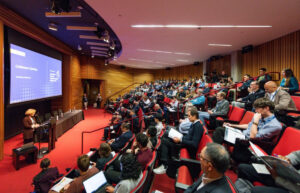
Batteries are critical to global competitiveness and domestic energy security. With their growing applications in the defense sector, they are also important to our national security. Yet today the U.S. represents only seven percent of the world’s battery production capacity, making it overly reliant on foreign supply chains and manufacturing.
Thus battery manufacturing is a topic of key importance with our stakeholders. The Office of Science has been supporting advanced battery research through programs such as the Energy Storage Research Alliance and the Aqueous Battery Consortium ABC, and the U.S. government has been focusing on battery manufacturing and robust materials supply chains. The California Energy Commission is also planning to invest significantly in the battery manufacturing sector in the next few years.
National labs also have recognized the importance of battery science and technology and have been working to support the growth of the domestic battery manufacturing sector. Berkeley Lab, SLAC National Accelerator Laboratory (SLAC), and Lawrence Livermore National Lab (LLNL) have partnered on annual battery research conferences since 2012, and organized another conference in September 2024, which focused on battery manufacturing.
The idea to focus the conference on battery manufacturing was built upon a coalition that pursued funding from the Department of Commerce (DOC) Economic Development Administration (EDA)’s Tech Hubs program. Although that application was not successful, the coalition grew to more than 200 organizations, representing California’s R&D capabilities (including the three national labs), higher education infrastructure, and venture capital. The coalition is pursuing various funding opportunities, including the California Energy Commission’s upcoming Pilot Line solicitation, the National Science Foundation’s Innovation Engine, and potential funding opportunities from the DOE’s Material Energy Supply Chain (MESC) Office. The group agreed that a conference would be valuable for collecting and sharing input with both federal and state stakeholders and to galvanize the coalition toward a shared common goal.
The conference also supports Berkeley Lab’s own mission and priorities. Gao Liu, a senior scientist and group leader of the Energy Storage and Distributed Resources Division’s Applied Energy Materials Group, said: “Battery manufacturing is a strategic priority for the Energy Technologies Area (ETA), and we need to better understand where our research and our technologies are going. In practical terms, battery manufacturing capabilities in the state would allow us to more easily take our technologies to the next step, to test the scale up of these technologies, and to refine our ideas and inventions.”
Input from the Ecosystem
On September 18 and 19, more than 300 people gathered at the David Brower Center in downtown Berkeley for the conference, titled “From Innovation to Manufacturing: California’s Battery Manufacturing Summit.” Co-organized by Berkeley Lab’s ETA, LLNL, and SLAC, the conference attracted thought leaders from industry, communities, and labor, workforce development strategists, members of the research community, and key stakeholders from local jurisdictions. Among the State of California and the federal government stakeholders attending the conference were: David Hochschild, chair of the CEC; Patty Monahan, commissioner of the CEC; Cammy Peterson, the CEC’s deputy director for Energy Systems, Innovation, and Strategy; Austin Brown, director of the DOE’s Vehicle Technologies Office; and Betony Jones, director of the DOE’s Office of Energy Jobs. Welcoming remarks were also made by California Senator Alex Padilla, Congresswoman Zoe Lofgren, Congressman Raul Ruiz, and Ashley Zumwalt Forbes, deputy director for batteries and critical materials at MESC.
The conference focused on three tracks: (i) how to build the innovation-to–manufacturing ecosystem; (ii) workforce development and education; and (iii) the finance infrastructure needed to support the growth of an advanced battery manufacturing sector.
Shannon Boettcher, a faculty senior scientist and deputy director of research for ETA’s Energy Storage and Distributed Resources Division, said, “This was an unusual and important effort. Inviting participants from the entire battery R&D ecosystem to work together, to think about how best to leverage our collective experiences and strengths to build advanced battery manufacturing capabilities, has not been done before.”
Opportunities for Berkeley Lab
The conference was, by any measure, a big success. For example, the interactions with the CEC ahead of and during the conference were helpful for the CEC’s own efforts. In fact, at the conference, the CEC announced a shared facility for pilot manufacturing for industry and lab users to accelerate battery R&D to prototypes. Right after the conference, the CEC held a scoping workshop on the “California Battery Pilot Manufacturing Line Funding Concept.”
“Because the California Energy Commission has long recognized the enabling role of storage in California’s climate policies, it has invested nearly $300M into building capabilities for lithium recovery, battery manufacturing, EV and stationary storage capacity, and second life and recycling,” said Alecia Ward, ETA’s program development lead. “We are very excited to see how they respond to the feedback from the Summit and the public comments from their recent workshop to support the growing ecosystem.”
For Berkeley Lab, the focus on battery manufacturing can also lead to additional opportunities. “Battery manufacturing offers many opportunities for Lab researchers and engineers – there are challenges related to engineering on different scales, data science needs, prototyping opportunities, and even opportunities related to the science of manufacturing, such as automation and new ways of manufacturing,” said Shannon.
He continued, “Ultimately, the Lab’s mission is to bring science solutions to the world, and bringing energy storage solutions to the world requires having conversations with others in the energy storage ecosystem.”

